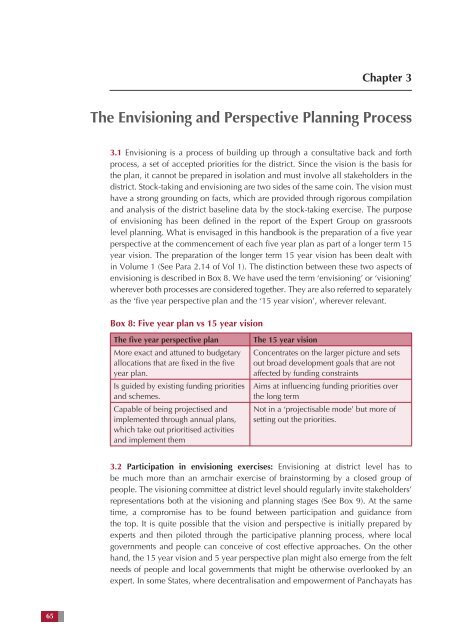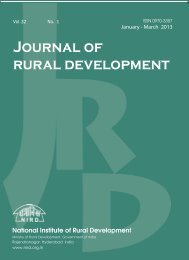Manual for Integrated District Planning - National Institute of Rural ...
Manual for Integrated District Planning - National Institute of Rural ...
Manual for Integrated District Planning - National Institute of Rural ...
You also want an ePaper? Increase the reach of your titles
YUMPU automatically turns print PDFs into web optimized ePapers that Google loves.
Chapter 3<br />
The Envisioning and Perspective <strong>Planning</strong> Process<br />
3.1 Envisioning is a process <strong>of</strong> building up through a consultative back and <strong>for</strong>th<br />
process, a set <strong>of</strong> accepted priorities <strong>for</strong> the district. Since the vision is the basis <strong>for</strong><br />
the plan, it cannot be prepared in isolation and must involve all stakeholders in the<br />
district. Stock-taking and envisioning are two sides <strong>of</strong> the same coin. The vision must<br />
have a strong grounding on facts, which are provided through rigorous compilation<br />
and analysis <strong>of</strong> the district baseline data by the stock-taking exercise. The purpose<br />
<strong>of</strong> envisioning has been defined in the report <strong>of</strong> the Expert Group on grassroots<br />
level planning. What is envisaged in this handbook is the preparation <strong>of</strong> a five year<br />
perspective at the commencement <strong>of</strong> each five year plan as part <strong>of</strong> a longer term 15<br />
year vision. The preparation <strong>of</strong> the longer term 15 year vision has been dealt with<br />
in Volume 1 (See Para 2.14 <strong>of</strong> Vol 1). The distinction between these two aspects <strong>of</strong><br />
envisioning is described in Box 8. We have used the term ‘envisioning’ or ‘visioning’<br />
wherever both processes are considered together. They are also referred to separately<br />
as the ‘five year perspective plan and the ‘15 year vision’, wherever relevant.<br />
Box 8: Five year plan vs 15 year vision<br />
The five year perspective plan<br />
More exact and attuned to budgetary<br />
allocations that are fixed in the five<br />
year plan.<br />
Is guided by existing funding priorities<br />
and schemes.<br />
Capable <strong>of</strong> being projectised and<br />
implemented through annual plans,<br />
which take out prioritised activities<br />
and implement them<br />
The 15 year vision<br />
Concentrates on the larger picture and sets<br />
out broad development goals that are not<br />
affected by funding constraints<br />
Aims at influencing funding priorities over<br />
the long term<br />
Not in a ‘projectisable mode’ but more <strong>of</strong><br />
setting out the priorities.<br />
3.2 Participation in envisioning exercises: Envisioning at district level has to<br />
be much more than an armchair exercise <strong>of</strong> brainstorming by a closed group <strong>of</strong><br />
people. The visioning committee at district level should regularly invite stakeholders’<br />
representations both at the visioning and planning stages (See Box 9). At the same<br />
time, a compromise has to be found between participation and guidance from<br />
the top. It is quite possible that the vision and perspective is initially prepared by<br />
experts and then piloted through the participative planning process, where local<br />
governments and people can conceive <strong>of</strong> cost effective approaches. On the other<br />
hand, the 15 year vision and 5 year perspective plan might also emerge from the felt<br />
needs <strong>of</strong> people and local governments that might be otherwise overlooked by an<br />
expert. In some States, where decentralisation and empowerment <strong>of</strong> Panchayats has<br />
65

















